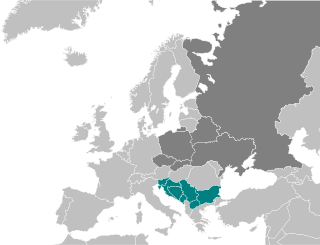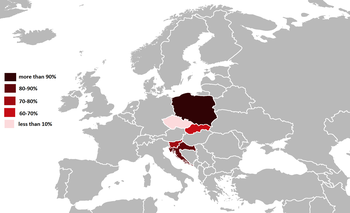
Pan-Slavism, a movement which crystallized in the mid-19th century, is the political ideology concerned with the advancement of integrity and unity for the Slavic peoples. Its main impact occurred in the Balkans, where non-Slavic empires had ruled the South Slavs for centuries. These were mainly the Byzantine Empire, Austria-Hungary, the Ottoman Empire, and Venice.

Slavs are an ethno-linguistic group of people who speak the various Slavic languages of the larger Balto-Slavic linguistic group of the Indo-European languages. They are native to Eurasia, stretching from Central, Southeastern and Eastern Europe, all the way north and eastwards to Northeast Europe, Northern Asia, and Central Asia, as well as historically in Western Europe and Western Asia. From the early 6th century they spread to inhabit most of Central, Eastern and Southeastern Europe. Today, there is a large Slavic diaspora throughout the Americas, particularly in the United States, Canada, Brazil and Argentina as a result of immigration.

Ruthenians and Ruthenes are exonyms of Latin origin, formerly used in eastern and Central Europe as common designations for East Slavs, particularly during the late medieval and early modern periods. Latin term Rutheni was found in medieval sources to describe the Slavic inhabitants of the Grand Duchy of Lithuania, as an exonymic designation for people of the former Kievan Rus', thus including ancestors of the modern Ukrainians, Rusyns, and the most of Belarusians. The use of Ruthenian designations was continued throughout the early modern period, acquiring several distinctive meanings, both in terms of their regional scopes and additional religious connotations.

Poles, or Polish people, are a nation and an ethnic group of predominantly West Slavic descent, who share a common history, culture, the Polish language and are identified with the country of Poland in Central Europe. The preamble to the Constitution of the Republic of Poland defines the Polish nation as comprising all the citizens of Poland, regardless of heritage or ethnicity. The vast majority of Poles adhere to Roman Catholicism.
The Poles come from different West Slavic tribes living on territories belonging later to Poland in the early Middle Ages.
Slavophilia was an intellectual movement originating from the 19th century that wanted the Russian Empire to be developed upon values and institutions derived from its early history. Slavophiles opposed the influences of Western Europe in Russia. There were also similar movements in Poland, Serbia and Croatia, Bulgaria, and Czechoslovakia. Depending on the historical context, its opposite could be termed Slavophobia, a fear of Slavic culture, or also what some Russian intellectuals called zapadnichestvo (westernism).

Rusyns, also known as Carpatho-Rusyns, or Rusnaks, are an East Slavic ethnic group from the Eastern Carpathians in Central Europe. They speak Rusyn, an East Slavic language variety, treated variously as either a distinct language or a dialect of the Ukrainian language. As traditional adherents of Eastern Christianity, the majority of Rusyns are Eastern Catholics, though a minority of Rusyns still practice Eastern Orthodoxy. Rusyns primarily self-identify as a distinct Slavic people and they are recognized as such in Croatia, Hungary, Poland, Romania, Serbia, and Slovakia, where they have official minority status. Alternatively, some identify more closely with their country of residence: as Polish, Slovak, or Ukrainian.
Anti-Slavic sentiment, also known as Slavophobia, a form of racism or xenophobia, refers to various negative attitudes towards Slavic peoples, the most common manifestation is the claim that the inhabitants of Slavic nations are inferior to other ethnic groups. Anti-Slavism reached its peak during World War II, when Nazi Germany declared Slavs, especially neighboring Poles to be subhuman (Untermensch) and planned to exterminate the majority of Slavic people.
The city of Vilnius, now the capital of Lithuania, and its surrounding region has been under various states. The Vilnius Region has been part of the Grand Duchy of Lithuania from the Lithuanian state's founding in the late Middle Ages to 1795, i.e. five hundred years. From then, the region was occupied by the Russian Empire until 1915, when the German Empire invaded it. After 1918 and throughout the Lithuanian Wars of Independence, Vilnius was disputed between the Republic of Lithuania and the Second Polish Republic. After the city was seized by the Republic of Central Lithuania with Żeligowski's Mutiny, the city was part of Poland throughout the Interwar period. Regardless, Lithuania claimed Vilnius as its capital. During World War II, the city changed hands many times, and the German occupation resulting in the destruction of Jews in Lithuania. From 1945 to 1990, Vilnius was the Lithuanian Soviet Socialist Republic's capital. From the dissolution of the Soviet Union, Vilnius has been part of Lithuania.

The South Slavs are a subgroup of Slavic peoples who speak the South Slavic languages. They inhabit a contiguous region in the Balkan Peninsula and the eastern Alps, and in the modern era are geographically separated from the body of West Slavic and East Slavic people by the Romanians, Hungarians, and Austrians in between, or geographically the Black Sea. The South Slavs today include the nations of Bosniaks, Bulgarians, Croats, Macedonians, Montenegrins, Serbs and Slovenes. They are the main population of the Southeastern European countries of Bosnia and Herzegovina, Bulgaria, Croatia, Montenegro, North Macedonia, Serbia and Slovenia.

Poland is one of the most religious countries in Europe. Though varied religious communities exist in Poland, most Poles adhere to Christianity. Within this, the largest grouping is the Roman Catholic Church: 92.9% of the population identified themselves with that denomination in 2015 ; according to the Institute for Catholic Church Statistics, 36.7% of Polish Catholic believers attended Sunday Mass in 2015. Poland is one of the most Catholic countries in the world; Neal Pease describes Poland as "Rome’s Most Faithful Daughter."

The Borders of Poland are 3,511 km (2,182 mi) or 3,582 km (2,226 mi) long. The neighboring countries are Germany to the west, the Czech Republic and Slovakia to the south, Ukraine and Belarus to the east, and Lithuania and the Russian province of Kaliningrad Oblast to the northeast. To the north, Poland is bordered by the Baltic Sea.

The following outline is provided as an overview of and topical guide to Poland:

The Polish census of 1931 or Second General Census in Poland was the second census taken in sovereign Poland during the interwar period, performed on December 9, 1931 by the Main Bureau of Statistics. It established that Poland's population amounted to 32 million people.
Protestantism in Poland is the third largest faith in Poland, after the Roman Catholic Church (32,440,722) and the Polish Orthodox Church (503,996). As of 2018 there were 103 registered Protestant denominations in Poland. Most Protestants in the country live in historically Protestant regions such as Cieszyn Silesia and Warmia-Masuria and in major urban areas. However, almost all urban and rural areas in Poland are predominantly Roman Catholic. The only town in the country with a majority Protestant population is Wisła.

The current Lithuania–Poland border has existed since the re-establishment of the independence of Lithuania on 11 March 1990. The length of the border is 104 kilometres (65 mi). It runs from the Lithuania–Poland–Russia tripoint southeast to the Belarus–Lithuania–Poland tripoint. It is an internal border of the European Union and the Schengen Zone.
Persecution of Eastern Orthodox Christians is the persecution faced by the clergy and the adherents of the Eastern Orthodox Church. Eastern Orthodox Christians have been persecuted in various periods when under the rule of non-Orthodox Christian political structures. In modern times, anti-religious political movements and regimes in some countries have held an anti-Orthodox stance.

The Slavs were Christianized in waves from the 7th to 12th century, though the process of replacing old Slavic religious practices began as early as the 6th century. Generally speaking, the monarchs of the South Slavs adopted Christianity in the 9th century, the East Slavs in the 10th, and the West Slavs between the 9th and 12th century. Saints Cyril and Methodius are attributed as "Apostles to the Slavs", having introduced the Byzantine-Slavic rite and Glagolitic alphabet, the oldest known Slavic alphabet and basis for the Early Cyrillic alphabet.

The Eastern Orthodox Slavs form a religious grouping of the Slavic peoples, including ethnic groups and nations that predominantly adhere to the Eastern Orthodox Christian faith and whose Churches follow the Byzantine Rite liturgy. Eastern Orthodoxy spread to Eastern Europe in the Early Middle Ages through Byzantine influence, and has been retained in several countries until today.

The North Slavs are a subgroup of Slavic peoples who speak the North Slavonic languages, a classification which is not universally accepted although it has been in use for several centuries. They separated from the common Slavic group in the 7th century CE, and established independent polities in Central and Eastern Europe by the 8th and 9th centuries.














